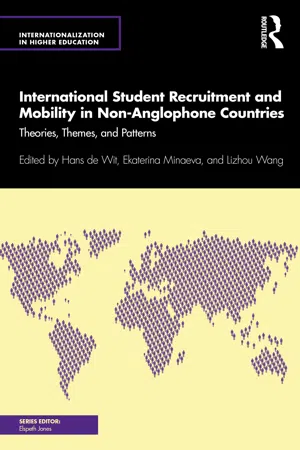
International Student Recruitment and Mobility in Non-Anglophone Countries
Theories, Themes, and Patterns
- 304 pages
- English
- ePUB (mobile friendly)
- Available on iOS & Android
International Student Recruitment and Mobility in Non-Anglophone Countries
Theories, Themes, and Patterns
About This Book
International Student Recruitment and Mobility in Non-Anglophone Countries offers a detailed analysis of global dimensions and trends in international student mobility and recruitment. It examines current data on student flows, policies and instruments, obstacles and opportunities for recruitment, and the roles of multiple stakeholders from different parts of the world.
Considering the current geopolitical developments and tensions, increased competition for global talent, health and sustainability concerns, growing nationalism, and other factors, non-Anglophone countries are likely to increase their recruitment efforts moving forward. This book highlights the initiatives and instruments of these countries to attract international students and build long-term internationalization strategies.
With case studies from Africa, Asia, Europe, the Middle East, and Latin America, International Student Recruitment and Mobility in Non-Anglophone Countries is a must-read text for international education policy advisors at the national and institutional levels and in the international higher education industry around the globe.
Frequently asked questions
Information
1 International student recruitment and mobility Dominant themes from literature and examples from key non-Anglophone countries
Introduction
The definition issue
| Source | Definition | Details |
|---|---|---|
| OECD | International students are those who received their prior education in another country and are not residents of their current country of study. When information of international students is not available, foreign students—students who are not citizens of the country in which they study—can be used as a proxy. | OECD provides the number of international students from various origins who are enrolled in each OECD country. |
| UNESCO | Students who have crossed a national or territorial border for the purpose of education and are now enrolled outside their country of origin. | UIS provides the most comprehensive data to date on international student inbound and outbound flows for more than 100 countries. By responding to an annual UIS questionnaire, countries report the number of internationally mobile students whom they are hosting and information on the students’ countries of origin. Some numbers are indirect estimates |
| International student mobility indicators are used to track the flows of tertiary-level students seeking higher education abroad. | ||
| Project Atlas | Students who undertake all or part of their higher education experience in a country other than their home country or who travel across a national boundary to a country other than their home country to undertake all or part of their higher education experience. | Project Atlas data cover both degree mobility and credit mobility in tertiary education, so the number reported is likely higher than those reported by UIS or OECD. |
| Specific Countries | Data from individual countries may provide further breakdowns of international students by sex, age, or degree types. Such data might be requested by relevant statistical agencies. | |
| Source: Elaborated by author from OECD, UNESCO, Project Atlas and country documents. | ||
| Type | Category in Statistics | Examples | |
|---|---|---|---|
| 1 | 3-12 months abroad to earn credits as part of the home degree program | “Credit mobility” students | Exchange students, international internships, (inter)national scholarship program students (Fulbright, ERASMUS) |
| 2 | Undergraduate degree or graduate degree abroad | “Diploma” or “degree mobility” students | With private funding, with (inter)national scholarships, or with income from work during study |
| 3 | Degree program in own country delivered by foreign providers | Excluded from statistics in most cases | Branch campuses and franchises |
| 4 | Joint or double degree program offered by national and foreign providers | “Temporary,” sometimes “credit,” or “diploma mobility” students. | Statistics show primarily the category of students who go abroad for an undergraduate or a graduate degree, pursuing the degree program completely, or mostly, at the foreign host institution. |
| Excluded from statistics in some cases | |||
| Usually excluded and less analyzed student groups | |||
| 1 | Students who go abroad for short-term, study-related visits | Group study tours, summer programs, intensive language courses, etc. Reliable data on this type of international student are difficult to acquire, although they represent a high number of mobile students. | |
| Sometimes referred to as “certificate mobility” | |||
| 2 | Students who study in nontraditional or nonhigher education international programs | International degree and exchange students in nonhigher education | |
| 3 | Online degree courses from a foreign provider, such as the online Ed.D. and online MBA programs. Because usually no visa or transnational travel is required, students are not included in national statistical data collections. | ||
| Source: Elaborated by author from OECD, UNESCO, Project Atlas and country documents. | |||
International student numbers
Table of contents
- Cover
- Half Title
- Series Page
- Title Page
- Copyright Page
- Contents
- List of illustrations
- Foreword to the Series, Internationalization in Higher Education
- Preface
- Acknowledgements
- List of acronyms
- Contributors
- 1 International student recruitment and mobility: Dominant themes from literature and examples from key non-Anglophone countries
- 2 National agencies and private actors in international student recruitment
- 3 English as medium of instruction in non-Anglophone countries: A global comparative analysis of policies, practices, and implications
- Part 2 Europe
- Part 3 Asia
- Part 4 Latin America and the Caribbean, the Middle East and North Africa, and sub-Saharan Africa
- Index